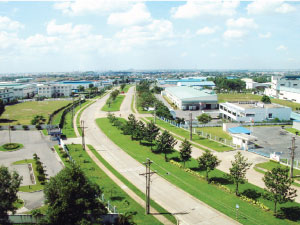
With its important position and dynamic development, the Southern Key Economic Zone (SKEZ) has become the strongest driving force of the Vietnamese economy.
With its important position and dynamic development, the Southern Key Economic Zone (SKEZ) has become the strongest driving force of the Vietnamese economy.
 |
Over the years, through use of their main advantages and capable transport infrastructure, localities in the SKEZ have built up associative links with each other to promote mutual development, creating a driving force for economic growth in the southern region and indeed the whole country since the early 1990s.
The SKEZ consists of six southeastern provinces and two southwestern provinces: Ba Ria-Vung Tau, Dong Nai, Binh Duong, Ho Chi Minh City, Tay Ninh, Binh Phuoc, Long An, and Tien Giang. Their links have created advantages that have benefited the entire region in its development and international integration process.
The SKEZ has long been a dynamic open economic zone acting as a gateway between Vietnam and the rest of the world. It has become a large industrial, commercial and financial center for the whole country. Currently, residents in the SKEZ account for nearly 17 percent of the total population in Vietnam, while the SKEZ itself represents more than eight percent of the country’s total area. In terms of financial contribution, the SKEZ contributes over 42 percent of Vietnam’s gross domestic product (GDP), nearly 40 percent of the country’s total export value, and about 60 percent towards the state budget. More than 60 percent of the total number of foreign investment projects in Vietnam are based in the SKEZ, making up over 50 percent of the total amount of foreign investment capital in the country. All these indexes point towards foreign investors’ trust in the SKEZ.
Looking towards new development levels
According to Associate Professor, Dr. Tran Hoang Ngan, Rector of the University of Finance and Marketing, Ho Chi Minh City is a gateway to the Mekong Delta, linking the southern region to the south-central region and the Central Highlands. Indeed, the city has demonstrated its central role in the SKEZ.
Binh Phuoc Province Communist Party Committee Secretary Nguyen Tan Hung said that Ho Chi Minh City had cooperated with other provinces to invest in major transport projects and other infrastructure facilities such as industrial zones, export-processing zones, wharves, and entrepots.
The cooperation between Ho Chi Minh City and Mekong Delta localities has created favorable conditions for businesses in these localities to sell their products in Ho Chi Minh City and gradually promote exports.
The SKEZ is implementing a regional infrastructure development program to eliminate the gap between different provinces in the region. Under this program, new seaports and airports will be built along with upgrading existing facilities to meet regional and international standards. The program will tighten the links between eight localities in the SKEZ and enhance their competitiveness, helping them achieve industrialization and modernization goals in the near future.
|
In June 2014 Prime Minister Nguyen Tan Dung issued Decision 252/QD-TTg approving the master plan for socioeconomic development in the Southern Key Economic Zone (SKEZ) towards 2020 with a vision to 2030. Under the plan, the SKEZ expects that from now until 2020 it would achieve an annual economic growth rate of approximately 8.5 percent (8.5-9 percent from 2016-2020); the per-capita GDP would reach US$5,000 and per-capita export value US$5,400. The SKEZ will concentrate on high-tech investment projects, looking towards becoming a human resource development center to cater for research and development needs. |
(Source:VEN)



